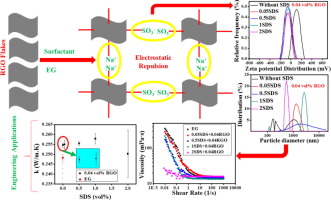当前位置:
X-MOL 学术
›
Int. J. Heat Mass Transf.
›
论文详情
Our official English website, www.x-mol.net, welcomes your feedback! (Note: you will need to create a separate account there.)
Experimental investigation on stability, thermal conductivity and rheological properties of rGO/ethylene glycol based nanofluids
International Journal of Heat and Mass Transfer ( IF 5.2 ) Pub Date : 2020-04-01 , DOI: 10.1016/j.ijheatmasstransfer.2019.118981 Syed Nadeem Abbas Shah , Syed Shahabuddin , Mohd Faizul Mohd Sabri , Mohd Faiz Mohd Salleh , Mohamad Azlin Ali , Nasir Hayat , Nor Azwadi Che Sidik , Mahendran Samykano , R. Saidur
International Journal of Heat and Mass Transfer ( IF 5.2 ) Pub Date : 2020-04-01 , DOI: 10.1016/j.ijheatmasstransfer.2019.118981 Syed Nadeem Abbas Shah , Syed Shahabuddin , Mohd Faizul Mohd Sabri , Mohd Faiz Mohd Salleh , Mohamad Azlin Ali , Nasir Hayat , Nor Azwadi Che Sidik , Mahendran Samykano , R. Saidur

|
Abstract The present study reports stability, thermal conductivity and rheological properties of reduced graphene oxide (rGO)/ethylene glycol (EG) based nanofluids at three volume concentrations (0.02%, 0.04%, 0.05%). The properties of the prepared nanofluids were comprehensively characterised and analysed by employing different techniques such as field emission scanning electron microscopy (FESEM), particle size analyser, Zetasizer, UV–vis spectrometry, rheometer, thermal conductivity meter and a pH measurement system. The effect of various surfactants such as SDS, SDBS and CTAB at four volume concentrations (0.05%, 0.5%, 1%, 2%) on the thermo-physical properties of the nanofluid were investigated. The experimental analysis revealed that the concentration of rGO and surfactants has greatly influenced stability, particle size distribution, dynamic viscosity and the thermal conductivity of the nanofluids. In addition, the viscoelastic rheological analysis shows considerable yield stress due to the presence of the rGO which was subsequently improved by surfactant, whereas non-Newtonian flow prevails at a shear rate below 10 s−1 followed by Newtonian behaviour afterward. Besides, temperature sweep measurements within temperature range (25–70 °C) indicates that the viscosity decrease with temperature and improvement persists. Consequently, the results suggested that the surfactants improve the zeta potential but the average particle size of colloids also increases due to agglomeration. The optimum rGO/EG nanofluid (0.02% rGO with 1% SDBS) was selected based on maximum thermal conductivity enhancement (11.3%), high relative concentration (~83% after four days) and the reduction in viscosity (~14.4% less than ethylene glycol). However, anomalous reduction in dynamic viscosity up to 22% and an increase in thermal conductivity up to 11.3% propose the use of surfactant base nanofluids in potential engineering applications.
中文翻译:

rGO/乙二醇基纳米流体稳定性、热导率和流变特性的实验研究
摘要 本研究报告了三种体积浓度(0.02%、0.04%、0.05%)下还原氧化石墨烯(rGO)/乙二醇(EG)基纳米流体的稳定性、热导率和流变特性。采用场发射扫描电子显微镜(FESEM)、粒度分析仪、Zetasizer、紫外-可见光谱、流变仪、热导仪和pH测量系统等不同技术对制备的纳米流体的性质进行了综合表征和分析。研究了 SDS、SDBS 和 CTAB 等四种体积浓度(0.05%、0.5%、1%、2%)的表面活性剂对纳米流体热物理性质的影响。实验分析表明,rGO 和表面活性剂的浓度对稳定性、粒度分布、纳米流体的动态粘度和热导率。此外,粘弹性流变分析表明,由于 rGO 的存在,产生了相当大的屈服应力,随后通过表面活性剂进行了改进,而非牛顿流动在低于 10 s-1 的剪切速率下占主导地位,然后是牛顿行为。此外,温度范围 (25–70 °C) 内的温度扫描测量表明粘度随温度降低并且持续改善。因此,结果表明表面活性剂提高了 zeta 电位,但胶体的平均粒径也由于团聚而增加。基于最大热导率增强(11.3%)选择最佳 rGO/EG 纳米流体(0.02% rGO 和 1% SDBS),高相对浓度(四天后~83%)和粘度降低(比乙二醇小~14.4%)。然而,动态粘度异常降低高达 22%,热导率增加高达 11.3%,建议在潜在的工程应用中使用基于表面活性剂的纳米流体。
更新日期:2020-04-01
中文翻译:

rGO/乙二醇基纳米流体稳定性、热导率和流变特性的实验研究
摘要 本研究报告了三种体积浓度(0.02%、0.04%、0.05%)下还原氧化石墨烯(rGO)/乙二醇(EG)基纳米流体的稳定性、热导率和流变特性。采用场发射扫描电子显微镜(FESEM)、粒度分析仪、Zetasizer、紫外-可见光谱、流变仪、热导仪和pH测量系统等不同技术对制备的纳米流体的性质进行了综合表征和分析。研究了 SDS、SDBS 和 CTAB 等四种体积浓度(0.05%、0.5%、1%、2%)的表面活性剂对纳米流体热物理性质的影响。实验分析表明,rGO 和表面活性剂的浓度对稳定性、粒度分布、纳米流体的动态粘度和热导率。此外,粘弹性流变分析表明,由于 rGO 的存在,产生了相当大的屈服应力,随后通过表面活性剂进行了改进,而非牛顿流动在低于 10 s-1 的剪切速率下占主导地位,然后是牛顿行为。此外,温度范围 (25–70 °C) 内的温度扫描测量表明粘度随温度降低并且持续改善。因此,结果表明表面活性剂提高了 zeta 电位,但胶体的平均粒径也由于团聚而增加。基于最大热导率增强(11.3%)选择最佳 rGO/EG 纳米流体(0.02% rGO 和 1% SDBS),高相对浓度(四天后~83%)和粘度降低(比乙二醇小~14.4%)。然而,动态粘度异常降低高达 22%,热导率增加高达 11.3%,建议在潜在的工程应用中使用基于表面活性剂的纳米流体。



























 京公网安备 11010802027423号
京公网安备 11010802027423号